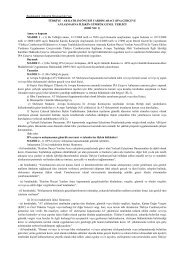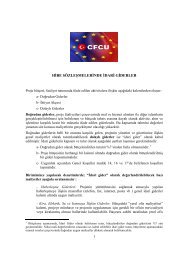Project Cycle Management Training Handbook - CFCU
Project Cycle Management Training Handbook - CFCU
Project Cycle Management Training Handbook - CFCU
Create successful ePaper yourself
Turn your PDF publications into a flip-book with our unique Google optimized e-Paper software.
<strong>Project</strong> <strong>Cycle</strong> <strong>Management</strong> <strong>Handbook</strong> <strong>Training</strong> Action for <strong>Project</strong> <strong>Cycle</strong> <strong>Management</strong><br />
CHAPTER 6 MONITORING AND REPORTING.....................................................55<br />
6.1 INTRODUCTION.......................................................................................................55<br />
6.2 DESIGNING A MONITORING SYSTEM........................................................................56<br />
6.2.1 Analyse <strong>Project</strong> Objectives..........................................................................57<br />
6.2.2 Review Implementation Procedures.............................................................57<br />
6.2.3 Review Indicators........................................................................................58<br />
6.2.4 Reporting....................................................................................................59<br />
6.3 SUMMARY..............................................................................................................62<br />
CHAPTER 7 PROJECT REVIEW AND EVALUATION..........................................63<br />
7.1 INTRODUCTION.......................................................................................................63<br />
7.2 EVALUATION CRITERIA...........................................................................................63<br />
7.3 LINKAGE TO THE LOGFRAME...................................................................................64<br />
7.3.1 Costs...........................................................................................................64<br />
7.3.2 Activities.....................................................................................................65<br />
7.3.3 Results ........................................................................................................65<br />
7.3.4 <strong>Project</strong> Purpose ..........................................................................................66<br />
7.3.5 Overall Objectives.......................................................................................66<br />
7.4 OPPORTUNITIES FOR EVALUATION ..........................................................................67<br />
7.5 SUMMARY..............................................................................................................68<br />
Index of Figures<br />
Figure 1: <strong>Training</strong> Objectives ...........................................................................................................................1<br />
Figure 2: Improving <strong>Project</strong> Quality .................................................................................................................3<br />
Figure 4: Rationale for PCM ............................................................................................................................9<br />
Figure 5: PCM Principles ...............................................................................................................................11<br />
Figure 6: The Integrated Approach .................................................................................................................12<br />
Figure 7: The Logical Framework Approach...................................................................................................15<br />
Figure 8: A Problem Tree...............................................................................................................................18<br />
Figure 9: Transforming Problems into Objectives ...........................................................................................19<br />
Figure 10: An Objective Tree .........................................................................................................................20<br />
Figure 11: Strategy Selection..........................................................................................................................21<br />
Figure 12: The Logframe Matrix ....................................................................................................................23<br />
Figure 13: The Relationship between Results and <strong>Project</strong> Purpose...................................................................24<br />
Figure 14: Transposing Objectives into the Logframe .....................................................................................25<br />
Figure 15: Specifying Assumptions ................................................................................................................26<br />
Figure 16: The Role of Assumptions...............................................................................................................27<br />
Figure 17: The Assumptions Algorithm..........................................................................................................27<br />
Figure 18: Ensuring that OVIs are Specific .....................................................................................................29<br />
Figure 19: Indicators and Aid <strong>Management</strong> ....................................................................................................30<br />
Figure 20: The Relationship Between Cost and Complexity in the Collection of Data......................................31<br />
Figure 21: An Example of a Completed Logframe ..........................................................................................33<br />
Figure 22: Activity and Resource Schedules ...................................................................................................36<br />
Figure 23: Example of an Activity Schedule ...................................................................................................40<br />
Figure 24: Example of a Resource Schedule ...................................................................................................41<br />
Figure 25: The Role of Terms of Reference in <strong>Project</strong> Preparation ..................................................................44<br />
Figure 26: Marking Problems & Objectives in a <strong>Project</strong> Proposal....................................................................45<br />
Figure 27: Terms of reference for a Feasibility Study......................................................................................51<br />
Figure 28: The Quality Assessment Tool ........................................................................................................52<br />
Figure 29: How the Quality Assessment Tool works .......................................................................................53<br />
Figure 30: Monitoring ....................................................................................................................................55<br />
Figure 31: Information Needs and Levels of <strong>Management</strong>...............................................................................57<br />
Figure 32: Evaluation.....................................................................................................................................63<br />
Figure 33: Linking Indicators to the Logframe................................................................................................65





